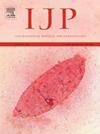越过近北极生物地理分界线向北迁移;感染 Astyanax 的新热带 Gyrodactylus spp.穿越了跨墨西哥火山带。
IF 3.2
2区 医学
Q1 PARASITOLOGY
引用次数: 0
摘要
新热带鱼类蓑鲉属(蓑鲉科)及其相关的蠕虫随着美洲生物大交汇(GABI)从南美洲向北迁移:约 150 种蓑鲉属鱼类遍布南美洲和中美洲,直至墨西哥-美国边境。大多数蛛形纲动物分布在跨墨西哥火山带(TMVB)以南,该火山带将墨西哥一分为二,是新热带地区和近北极地区的主要过渡地带。在这里,我们描述了感染墨西哥Astyanax属的单基因Gyrodactylus属寄生虫的特征:在TMBV以南为Astyanax aeneus,在TMBV以北为Astyanax mexicanus。根据形态学、系统发生学(内部转录隔距(ITS)和细胞色素氧化酶亚单位 II(cox 2))和形态计量数据统计分析,我们确认了 Gyrodactylus pakan 和 Gyrodactylus teken 的有效性,并建立了两个新种 Gyrodactylus aphaa n. sp.这四种旋毛虫是形态上隐蔽物种复合体的一部分,它们在系统发育上彼此密切相关,是寄生于巴西颊蟾蜍的Gyrodactylus carolinae和Gyrodactylus heteracanthus的姊妹物种。四个天旋地转虫系(G. pakan、G. ricardoi n. sp、根据 ITS 系统发育,巴西的寄生虫与所有墨西哥旋毛虫形成姊妹支系,其衍生支系分布在墨西哥逐渐偏北的纬度地区--这是 TMVB 以北衍生最多的三个物种。这表明旋毛虫物种是逐渐分化的,可能是随着其腥臭鱼类宿主在TMVB以北地区定居并适应新环境而分化的。本文章由计算机程序翻译,如有差异,请以英文原文为准。

Northward migration past the nearctic biogeographical divide; neotropical Gyrodactylus spp. infecting Astyanax have crossed the Trans-Mexican Volcanic Belt
The neotropical fish genus Astyanax (Characidae) and its associated helminths migrated northward from South America following the Great American Biotic Interchange (GABI): ca. 150 Astyanax spp. are found throughout South and Central America, up to the Mexico-USA border. Most characids are distributed south of the Trans-Mexican Volcanic Belt (TMVB), which bisects the country and represents a major transition zone between the neotropical and nearctic realms. Here, we characterize parasites of the monogenean genus Gyrodactylus infecting Astyanax spp. in Mexico: Astyanax aeneus south of the TMBV, Astyanax mexicanus north of it. Based on morphological, phylogenetic (internal transcribed spacer (ITS) and cytochrome oxidase subunit II (cox 2)) and statistical analyses of morphometric data, we confirmed the validity of Gyrodactylus pakan and Gyrodactylus teken, and erected two new species, Gyrodactylus aphaa n. sp. and Gyrodactylus ricardoi n. sp. These four gyrodactylids are part of a complex of morphologically cryptic species, which are phylogenetically closely related to each other, and sister species to Gyrodactylus carolinae and Gyrodactylus heteracanthus, parasites of characins in Brazil. Four gyrodactylid lineages (G. pakan, G. ricardoi n. sp., G. teken, Gyrodactylus sp. A) are distributed north of the TMVB; G. pakan is also widely distributed south of the TMVB, together with G. aphaa n. sp. Based on the ITS phylogeny, Brazilian parasites form a sister clade to all Mexican gyrodactylids, whose derived clades are distributed in progressively more northerly latitudes in Mexico – the three most-derived species north of the TMVB. This would suggest that gyrodactylid species diverged gradually, presumably as their characid fish hosts colonized and adapted to new environments north of the TMVB.
求助全文
通过发布文献求助,成功后即可免费获取论文全文。
去求助
来源期刊
CiteScore
8.40
自引率
2.50%
发文量
76
审稿时长
23 days
期刊介绍:
International Journal for Parasitology offers authors the option to sponsor nonsubscriber access to their articles on Elsevier electronic publishing platforms. For more information please view our Sponsored Articles page. The International Journal for Parasitology publishes the results of original research in all aspects of basic and applied parasitology, including all the fields covered by its Specialist Editors, and ranging from parasites and host-parasite relationships of intrinsic biological interest to those of social and economic importance in human and veterinary medicine and agriculture.

 求助内容:
求助内容: 应助结果提醒方式:
应助结果提醒方式:


